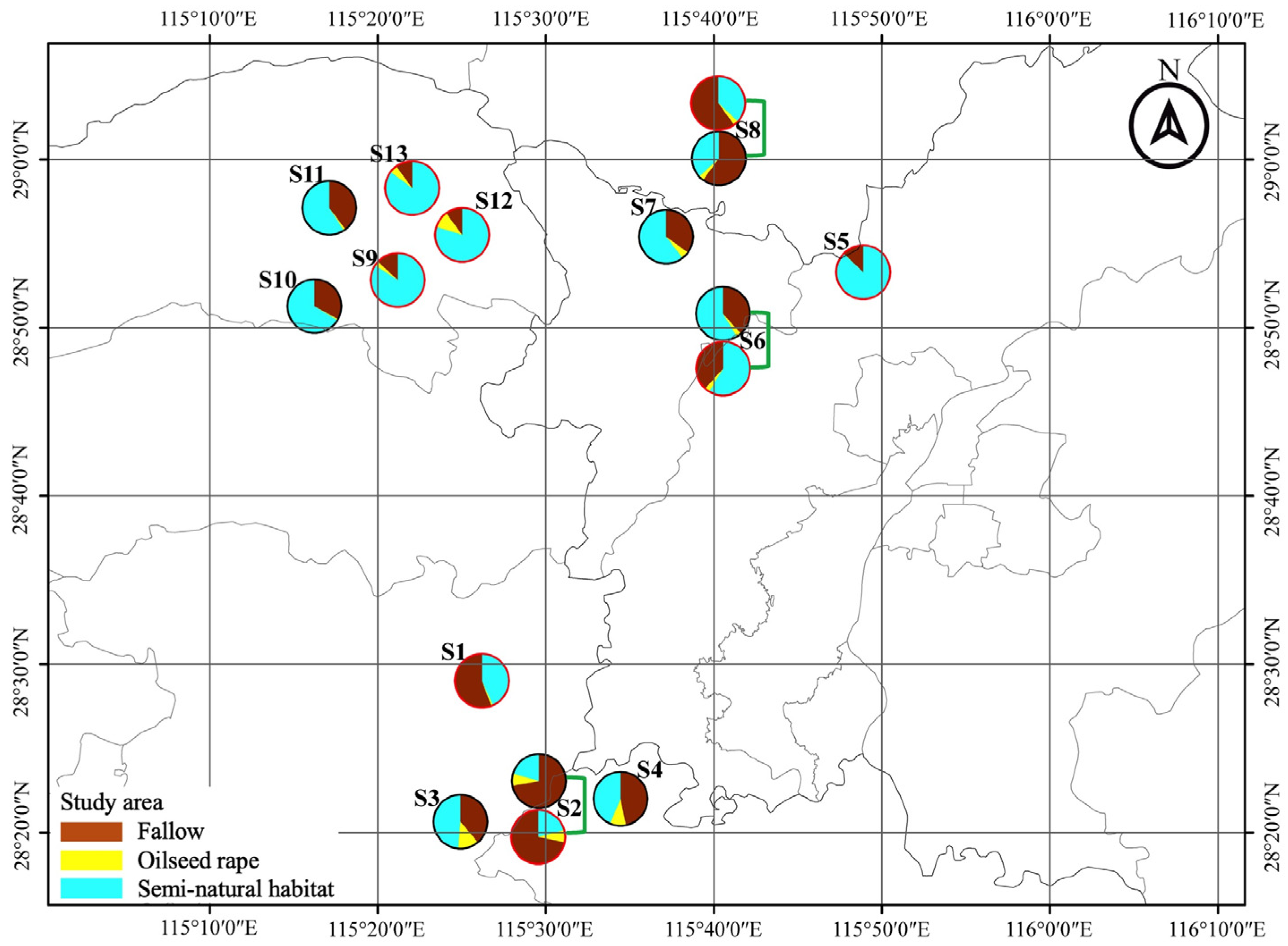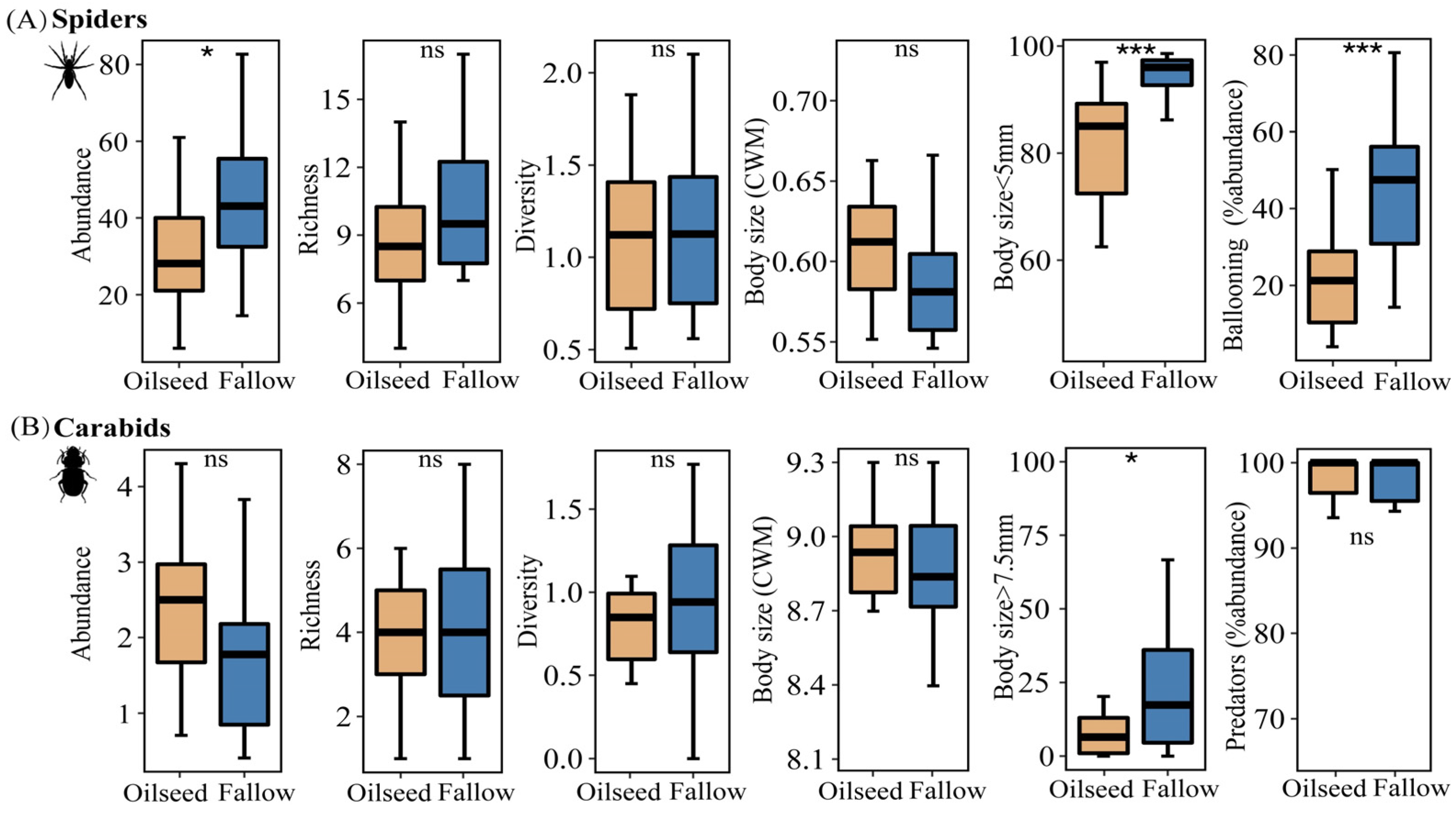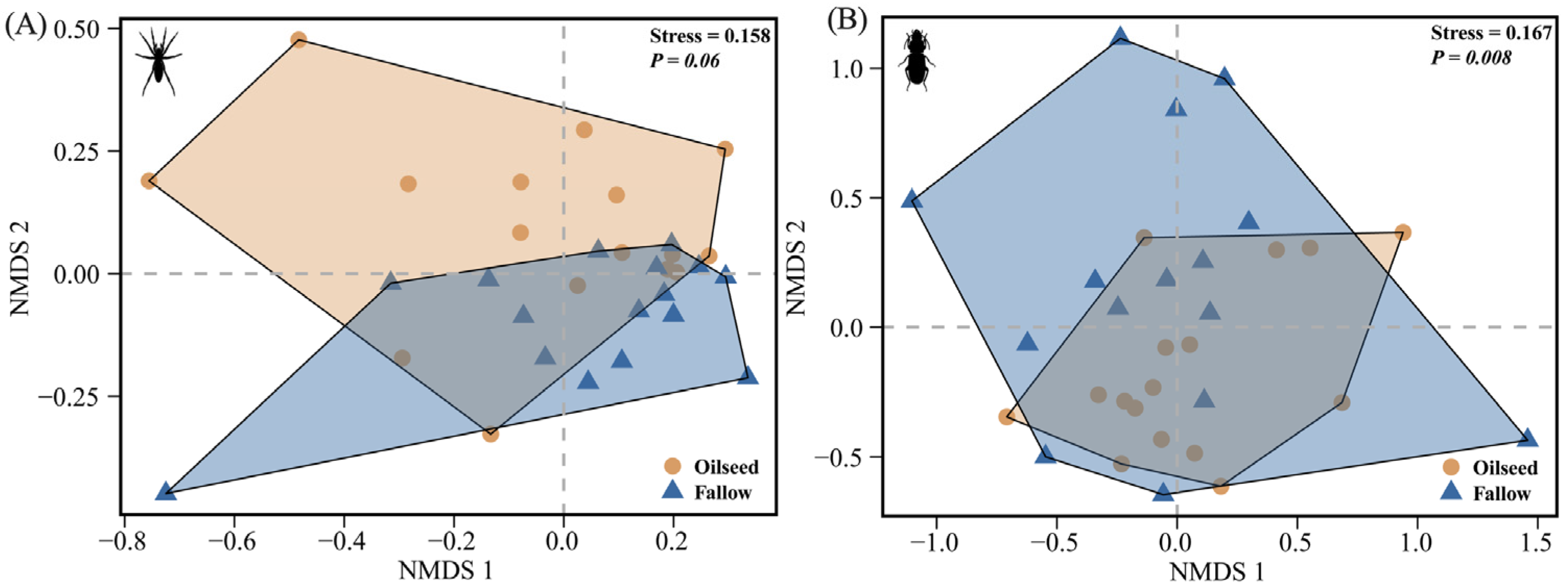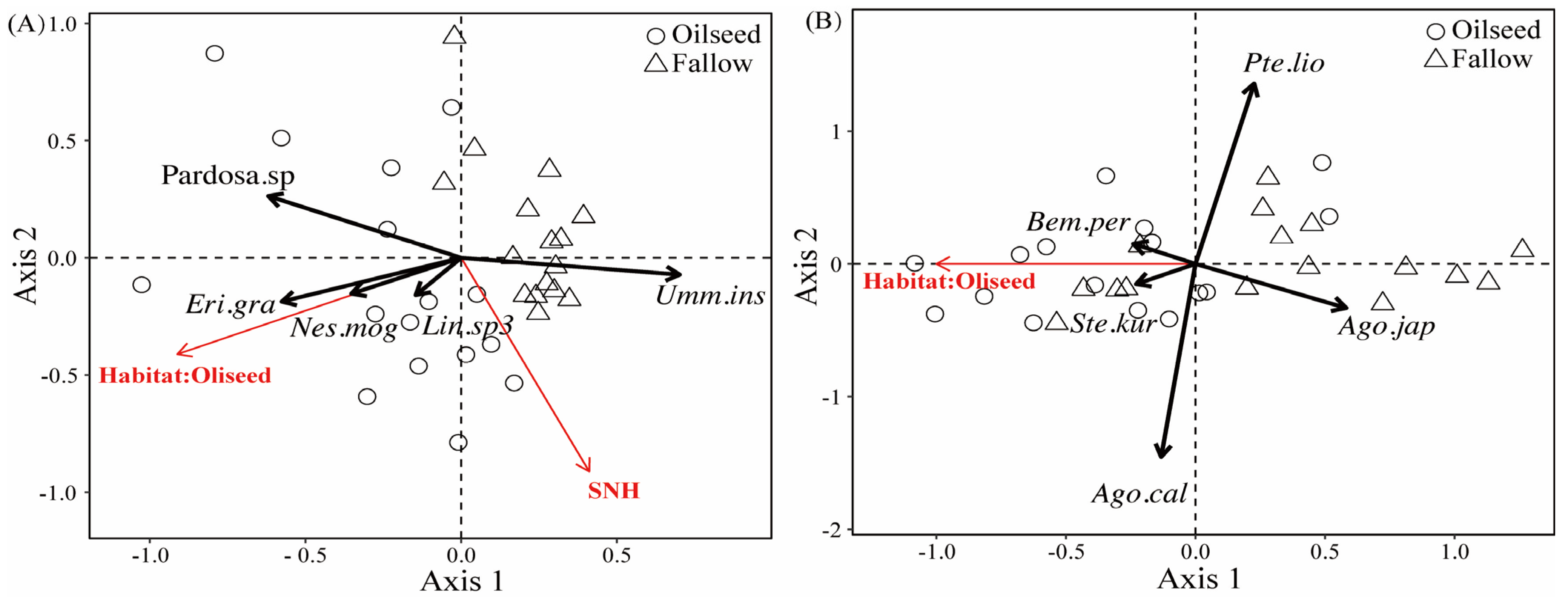Response of Spider and Epigaeic Beetle Assemblages to Overwinter Planting Regimes and Surrounding Landscape Compositions
Abstract
:Simple Summary
Abstract
1. Introduction
2. Materials and Methods
2.1. Study Area
2.2. Sampling
2.3. Spider and Carabid Community Traits
2.4. Data Analysis
- i.
- In order to analyze the spiders’ and carabids’ density between different months in the rice fallow field and oilseed rape field, the alpha diversity (abundance, richness, diversity), and functional traits (for spiders: body size, dispersal ability; for carabids: feeding trait, body size) during the sampling period, a paired t-test or the Kruskal–Wallis test was used. We also calculated community-weighted mean values (CWMs) of spiders’ and carabids’ body sizes between the fallow rice field and oilseed rape field, which were calculated as follows:
- ii.
- We performed a non-metric multidimensional scaling (NMDS) ordination based on the Bray–Curtis distance matrix from the relative abundance of all adult species using the “vegan” package in R [49], to visualize the spatial community dissimilarity of spiders and carabids in fallow rice fields and oilseed rape fields. Subsequently, PERMANOVAs (999 permutations) were used to test for significant difference in species assemblages between the oilseed rape fields and the fallow rice fields.
- iii.
- Finally, we analyzed the landscape composition within a radius of 1000 m around the focal patch. We used a redundancy analysis (RDA) to assess the interactions between landscape variables and all ground predators’ composition, and to visualize the responses of significant indicator species in biplots of the RDA. Using the species composition as the dependent variables, landscape composition as the argument variables in the RDA, and stepwise forward selection to find the optimum model with predictive redundancy, we calculated the variance inflation factor (VIF < 5) to firmly exclude multicollinearity between explanatory variables [50]. The best-explained variation was selected in spiders and carabids with 999 Monte Carlo permutations. To avoid visual confusion, we only show the significant indicator species in the redundancy analysis. The other full figures are attached in Figure S1. RDA analyses were carried out using the “vegan” package in R [49].
3. Results
3.1. Monthly Dynamics of Spider and Carabid Density in FRs and OSRs
3.2. Alpha Diversity and Functional Traits of Spiders and Carabids
3.3. Composition of Spider and Carabid Assemblages in the FRs and the OSRs
3.4. Effect of Habitat Types and Landscape Compositions on Spider and Carabid Assemblages
4. Discussion
4.1. Effect of Habitat Types on Density and Diversity of Predators
4.2. Effect of Two Habitat Types on Functional Traits’ Diversity in Spiders and Carabids
4.3. Effect of Habitat Types and Landscape Compositions on Spider and Carabid Assemblages
5. Conclusions
Supplementary Materials
Author Contributions
Funding
Data Availability Statement
Acknowledgments
Conflicts of Interest
References
- Tscharntke, T.; Grass, I.; Wanger, T.C.; Westphal, C.; Batáry, P. Beyond organic farming–harnessing biodiversity-friendly landscapes. Trends Ecol. Evol. 2021, 36, 919–930. [Google Scholar] [CrossRef]
- Landis, D.A. Designing agricultural landscapes for biodiversity-based ecosystem services. Basic Appl. Ecol. 2017, 18, 1–12. [Google Scholar] [CrossRef]
- Zabel, F.; Delzeit, R.; Schneider, J.M.; Seppelt, R.; Mauser, W.; Václavík, T. Global impacts of future cropland expansion and intensification on agricultural markets and biodiversity. Nat. Commun. 2019, 10, 2844. [Google Scholar] [CrossRef] [PubMed]
- Cohen, A.L.; Crowder, D.W. The impacts of spatial and temporal complexity across landscapes on biological control: A review. Curr. Opin. Insect Sci. 2017, 20, 13–18. [Google Scholar] [CrossRef] [PubMed]
- Paredes, D.; Rosenheim, J.A.; Chaplin-Kramer, R.; Winter, S.; Karp, D.S. Landscape simplification increases vineyard pest outbreaks and insecticide use. Ecol. Lett. 2021, 24, 73–83. [Google Scholar] [CrossRef] [PubMed]
- Jeanneret, P.; Aviron, S.; Alignier, A.; Lavigne, C.; Helfenstein, J.; Herzog, F.; Kay, S.; Petit, S. Agroecology landscapes. Landsc. Eco. 2021, 36, 2235–2257. [Google Scholar] [CrossRef] [PubMed]
- Kuesel, R.; Gonthier, D.J.; Cruz, M.; Vaiyda, C.; Iverson, A.L.; Perfecto, I. Local management and landscape use intensity associated with a coffee leaf-chewing beetle. Agroecol. Sustain. Food 2014, 38, 532–540. [Google Scholar] [CrossRef]
- Zhao, Z.; Gao, F.; He, D.; Ge, F. Ecologically based pest management at multiple spatial scales. Sci. Sin. Vitae 2015, 45, 755–767. [Google Scholar] [CrossRef]
- Haaland, C.; Naisbit, R.E.; Bersier, L.F. Sown wildflower strips for insect conservation: A review. Insect Conserv. Divers. 2011, 4, 155–172. [Google Scholar] [CrossRef]
- Bianchi, F.J.; Booij, C.; Tscharntke, T. Sustainable pest regulation in agricultural landscapes: A review on landscape composition, biodiversity and natural pest control. Proc. R. Soc. B-Biol. Sci. 2006, 273, 1715–1727. [Google Scholar] [CrossRef]
- Szalai, M.; Kiss, J.; Kövér, S.; Toepfer, S. Simulating crop rotation strategies with a spatiotemporal lattice model to improve legislation for the management of the maize pest Diabrotica virgifera. Agric. Syst. 2014, 124, 39–50. [Google Scholar] [CrossRef]
- Birkhofer, K.; Wolters, V. The global relationship between climate, net primary production and the diet of spiders. Glob. Ecol. Biogeogr. 2012, 21, 100–108. [Google Scholar] [CrossRef]
- Michalko, R.; Pekár, S. Different hunting strategies of generalist predators result in functional differences. Oecologia 2016, 181, 1187–1197. [Google Scholar] [CrossRef] [PubMed]
- Labruyere, S.; Bohan, D.A.; Biju-Duval, L.; Ricci, B.; Petit, S. Local, neighbor and landscape effects on the abundance of weed seed-eating carabids in arable fields: A nationwide analysis. Basic Appl. Ecol. 2016, 17, 230–239. [Google Scholar] [CrossRef]
- Wang, M.; Yu, Z.; Liu, Y.; Wu, P.; Axmacher, J.C. Taxon- and functional group-specific responses of ground beetles and spiders to landscape complexity and management intensity in apple orchards of the North China Plain. Agric. Ecosyst. Environ. 2022, 323, 107700. [Google Scholar] [CrossRef]
- Woodcock, B.A.; Harrower, C.; Redhead, J.; Edwards, M.; Vanbergen, A.J.; Heard, M.S.; Roy, D.B.; Pywell, R.F.; Lewis, O. National patterns of functional diversity and redundancy in predatory ground beetles and bees associated with key UK arable crops. J. Appl. Ecol. 2014, 51, 142–151. [Google Scholar] [CrossRef]
- Rusch, A.; Birkhofer, K.; Bommarco, R.; Smith, H.G.; Ekbom, B. Predator body sizes and habitat preferences predict predation rates in an agroecosystem. Basic Appl. Ecol. 2015, 16, 250–259. [Google Scholar] [CrossRef]
- Schirmel, J.; Blindow, I.; Buchholz, S. Life-history trait and functional diversity patterns of ground beetles and spiders along a coastal heathland successional gradient. Basic Appl. Ecol. 2012, 13, 606–614. [Google Scholar] [CrossRef]
- Lövei, G.L.; Sunderland, K.D. Ecology and behavior of ground beetles (Coleoptera: Carabidae). Annu Rev Entomol. 1996, 41, 231–256. [Google Scholar] [CrossRef]
- Schirmel, J.; Thiele, J.; Entling, M.H.; Buchholz, S. Trait composition and functional diversity of spiders and carabids in linear landscape elements. Agric. Ecosyst. Environ. 2016, 235, 318–328. [Google Scholar] [CrossRef]
- Ng, K.; Barton, P.S.; Blanchard, W.; Evans, M.J.; Lindenmayer, D.B.; Macfadyen, S.; McIntyre, S.; Driscoll, D.A. Disentangling the effects of farmland use, habitat edges, and vegetation structure on ground beetle morphological traits. Oecologia 2018, 188, 645–657. [Google Scholar] [CrossRef] [PubMed]
- Fahrig, L.; Baudry, J.; Brotons, L.; Burel, F.G.; Crist, T.O.; Fuller, R.J.; Sirami, C.; Siriwardena, G.M.; Martin, J.L. Functional landscape heterogeneity and animal biodiversity in agricultural landscapes. Ecol. Lett. 2011, 14, 101–112. [Google Scholar] [CrossRef]
- Gámez-Virués, S.; Perović, D.J.; Gossner, M.M.; Börschig, C.; Blüthgen, N.; De Jong, H.; Simons, N.K.; Klein, A.-M.; Krauss, J.; Maier, G. Landscape simplification filters species traits and drives biotic homogenization. Nat. Commun. 2015, 6, 8568. [Google Scholar] [CrossRef] [PubMed]
- Boetzl, F.A.; Krimmer, E.; Krauss, J.; Steffan-Dewenter, I. Agri-environmental schemes promote ground-dwelling predators in adjacent oilseed rape fields: Diversity, species traits and distance-decay functions. J. Appl. Ecol. 2019, 56, 10–20. [Google Scholar] [CrossRef]
- Isbell, F.; Adler, P.R.; Eisenhauer, N.; Fornara, D.; Kimmel, K.; Kremen, C.; Letourneau, D.K.; Liebman, M.; Polley, H.W.; Quijas, S. Benefits of increasing plant diversity in sustainable agroecosystems. J. Ecol. 2017, 105, 871–879. [Google Scholar] [CrossRef]
- Yousaf, M.; Li, J.; Lu, J.; Ren, T.; Cong, R.; Fahad, S.; Li, X. Effects of fertilization on crop production and nutrient-supplying capacity under rice-oilseed rape rotation system. Sci. Rep. 2017, 7, 1270. [Google Scholar] [CrossRef] [PubMed]
- Zhang, H.; Luo, G.; Wang, Y.; Fei, J.; Rong, X.; Peng, J.; Tian, C.; Zhang, Y. Crop rotation-driven change in physicochemical properties regulates microbial diversity, dominant components, and community complexity in paddy soils. Agric. Ecosyst. Environ. 2023, 343, 108278. [Google Scholar] [CrossRef]
- Katayama, N.; Odaya, Y.; Amano, T.; Yoshida, H. Spatial and temporal associations between fallow fields and Greater Painted Snipe density in Japanese rice paddy landscapes. Agric. Ecosyst. Environ. 2020, 295, 106892. [Google Scholar] [CrossRef]
- Birkhofer, K.; Fevrier, V.; Heinrich, A.E.; Rink, K.; Smith, H.G. The contribution of CAP greening measures to conservation biological control at two spatial scales. Agric. Ecosyst. Environ. 2018, 255, 84–94. [Google Scholar] [CrossRef]
- Rowen, E.K.; Tooker, J.F. Ground predator activity-density and predation rates are weakly supported by dry-stack cow manure and wheat cover crops in no-till maize. Environ. Entomol. 2021, 50, 46–57. [Google Scholar] [CrossRef]
- Sun, J.; Pang, S.; Wang, X.; Wang, G.; Zhu, Z.; Cheng, J.; Bai, Y. Molecular quantification of spider preying on springtails in winter-spring fallow waterlogged paddy fields. Appl. Entomol. Zool. 2021, 56, 165–172. [Google Scholar] [CrossRef]
- Emmerson, M.; Morales, M.B.; Oñate, J.J.; Batary, P.; Berendse, F.; Liira, J.; Aavik, T.; Guerrero, I.; Bommarco, R.; Eggers, S. How agricultural intensification affects biodiversity and ecosystem services. Adv. Ecol. Res. 2016, 55, 43–97. [Google Scholar] [CrossRef]
- Dormann, C.F.; Schweiger, O.; Augenstein, I.; Bailey, D.; Billeter, R.; De Blust, G.; DeFilippi, R.; Frenzel, M.; Hendrickx, F.; Herzog, F. Effects of landscape structure and land-use intensity on similarity of plant and animal communities. Glob. Ecol. Biogeogr. 2007, 16, 774–787. [Google Scholar] [CrossRef]
- Öberg, S.; Mayr, S.; Dauber, J. Landscape effects on recolonisation patterns of spiders in arable fields. Agric. Ecosyst. Environ. 2008, 123, 211–218. [Google Scholar] [CrossRef]
- Yarwood, E.; Drees, C.; Niven, J.E.; Gawel, M.; Schuett, W. Sex differences in morphology across an expanding range edge in the flightless ground beetle, Carabus hortensis. Ecol. Evol. 2021, 11, 9949–9957. [Google Scholar] [CrossRef] [PubMed]
- Dominik, C.; Seppelt, R.; Horgan, F.G.; Settele, J.; Václavík, T. Landscape heterogeneity filters functional traits of rice arthropods in tropical agroecosystems. Ecol. Appl. 2022, 32, e2560. [Google Scholar] [CrossRef] [PubMed]
- Riková, J.; Kádár, F.; Szalkovszki, O.; Kovács-Hostyánszki, A.; Báldi, A.; Elek, Z. Scale-dependent environmental filtering of ground-dwelling predators in winter wheat and adjacent set-aside areas in Hungary. J. Insect Conserv. 2020, 24, 751–763. [Google Scholar] [CrossRef]
- World Spider Catalog. Version 24; Natural History Museum Bern: Bern, Switzerland, 2023; Available online: http://wsc.nmbe.ch/ (accessed on 9 October 2022).
- Bell, J.; Bohan, D.; Shaw, E.; Weyman, G. Ballooning dispersal using silk: World fauna, phylogenies, genetics and models. Bull. Entomol. Res. 2005, 95, 69–114. [Google Scholar] [CrossRef]
- Duan, M.; Hu, W.; Liu, Y.; Yu, Z.; Li, X.; Wu, P.; Zhang, F.; Shi, H.; Baudry, J. The influence of landscape alterations on changes in ground beetle (Carabidae) and spider (Araneae) functional groups between 1995 and 2013 in an urban fringe of China. Sci. Total Environ. 2019, 689, 516–525. [Google Scholar] [CrossRef]
- Zhang, Z.; Wang, L. Chinese Spiders Illustrated; Chongqing University Press: Chongqing, China, 2017; p. 924. [Google Scholar]
- Blandenier, G. Ballooning of spiders (Araneae) in Switzerland: General results from an eleven-year survey. J. Arachnol. 2009, 14, 308–316. [Google Scholar] [CrossRef]
- Lichtenberg, E.M.; Kennedy, C.M.; Kremen, C.; Batary, P.; Berendse, F.; Bommarco, R.; Bosque-Pérez, N.A.; Carvalheiro, L.G.; Snyder, W.E.; Williams, N.M. A global synthesis of the effects of diversified farming systems on arthropod diversity within fields and across agricultural landscapes. Glob. Chang. Biol. 2017, 23, 4946–4957. [Google Scholar] [CrossRef]
- Gayer, C.; Lövei, G.L.; Magura, T.; Dieterich, M.; Batáry, P. Carabid functional diversity is enhanced by conventional flowering fields, organic winter cereals and edge habitats. Agric. Ecosyst. Environ. 2019, 284, 106579. [Google Scholar] [CrossRef]
- Ranjha, M.; Irmler, U. Age of grassy strips influences biodiversity of ground beetles in organic agro-ecosystems. Agri. Sci. 2013, 4, 209–218. [Google Scholar] [CrossRef]
- Melis, C.; Olsen, C.B.; Hyllvang, M.; Gobbi, M.; Stokke, B.G.; Røskaft, E. The effect of traffic intensity on ground beetle (Coleoptera: Carabidae) assemblages in central Sweden. J. Insect Conserv. 2010, 14, 159–168. [Google Scholar] [CrossRef]
- R Core Team. R: A Language and Environment for Statistical Computing; R Foundation for Statistical Computinng: Vienna, Austria, 2002; Available online: https://www.R-project.org. (accessed on 1 April 2022).
- Ricotta, C.; Moretti, M. CWM and Rao’s quadratic diversity: A unified framework for functional ecology. Oecologia 2011, 167, 181–188. [Google Scholar] [CrossRef] [PubMed]
- Oksanen, J.; Simpson, G.; Blanchet, F.; Kindt, R.; Legendre, P.; Minchin, P.R.; O’Hara, R.B.; Solymos, P.; Stevens, M.H.H.; Szoecs, E.; et al. Vegan: Community Ecology Package. R Package Version 2.6-2. 2022. Available online: https://CRAN.R-project.org/package=vegan (accessed on 1 April 2022).
- Graham, M.H. Confronting multicollinearity in ecological multiple regression. Ecology 2003, 84, 2809–2815. [Google Scholar] [CrossRef]
- Blandenier, G.; Bruggisser, O.T.; Rohr, R.P.; Bersier, L.-F. Are phenological patterns of ballooning spiders linked to habitat characteristics? J. Arachnol. 2013, 41, 126–132. [Google Scholar] [CrossRef]
- Li, X.; Liu, Y.; Duan, M.; Yu, Z.; Axmacher, J.C. Different response patterns of epigaeic spiders and carabid beetles to varying environmental conditions in fields and semi-natural habitats of an intensively cultivated agricultural landscape. Agric. Ecosyst. Environ. 2018, 264, 54–62. [Google Scholar] [CrossRef]
- Freiberg, J.A.; de Sales Dambros, C.; Rodrigues, E.N.L.; Teixeira, R.A.; Vieira, Â.D.H.N.; de Almeida, H.S.; de Faccio Carvalho, P.C.; Jacques, R.J.S. Increased grazing intensity in pastures reduces the abundance and richness of ground spiders in an integrated crop-livestock system. Agron. Sustain. Dev. 2020, 40, 1. [Google Scholar] [CrossRef]
- Zhang, X.; Axmacher, J.C.; Wu, P.; Zhang, X.; Liu, Y. Productive oilseed rape strips supplement seminatural field-margins in promoting ground-dwelling predatory invertebrates in agricultural landscapes. J. Insect Sci. 2019, 19, 18. [Google Scholar] [CrossRef]
- Sivcev, L.; Sivcev, I.; Graora, D.; Tomi, V.; Dudi, B.D. Ground Beetle Assemblages Affected by Oilseed Rape Management Practice. Acta Zool. Bulg. 2018, 70, 367–376. [Google Scholar]
- Marrec, R.; Badenhausser, I.; Bretagnolle, V.; Börger, L.; Roncoroni, M.; Guillon, N.; Gauffre, B. Crop succession and habitat preferences drive the distribution and abundance of carabid beetles in an agricultural landscape. Agric. Ecosyst. Environ. 2015, 199, 282–289. [Google Scholar] [CrossRef]
- Gallé, R.; Happe, A.K.; Baillod, A.B.; Tscharntke, T.; Batáry, P. Landscape configuration, organic management, and within-field position drive functional diversity of spiders and carabids. J. Appl. Ecol. 2019, 56, 63–72. [Google Scholar] [CrossRef]
- Schuldt, A.; Bruelheide, H.; Durka, W.; Michalski, S.G.; Purschke, O.; Assmann, T. Tree diversity promotes functional dissimilarity and maintains functional richness despite species loss in predator assemblages. Oecologia 2014, 174, 533–543. [Google Scholar] [CrossRef] [PubMed]
- Entling, M.H.; Stämpfli, K.; Ovaskainen, O. Increased propensity for aerial dispersal in disturbed habitats due to intraspecific variation and species turnover. Oikos 2011, 120, 1099–1109. [Google Scholar] [CrossRef]
- Mestre, L.; Schirmel, J.; Hetz, J.; Kolb, S.; Pfister, S.C.; Amato, M.; Sutter, L.; Jeanneret, P.; Albrecht, M.; Entling, M.H. Both woody and herbaceous semi-natural habitats are essential for spider overwintering in European farmland. Agric. Ecosyst. Environ. 2018, 267, 141–146. [Google Scholar] [CrossRef]
- Rouabah, A.; Lasserre-Joulin, F.; Amiaud, B.; Plantureux, S. Emergent effects of ground beetles size diversity on the strength of prey suppression. Ecol. Entomol. 2014, 39, 47–57. [Google Scholar] [CrossRef]
- Holland, J.M.; Reynolds, C.J.M. The impact of soil cultivation on arthropod (Coleoptera and Araneae) emergence on arable land. Pedobiologia 2003, 47, 181–191. [Google Scholar] [CrossRef]
- Deppe, F.; Fischer, K. Landscape type affects the functional diversity of carabid beetles in agricultural landscapes. Insect Conserv. Divers. 2023, 16, 441–450. [Google Scholar] [CrossRef]
- Aviron, S.; Burel, F.; Baudry, J.; Schermann, N. Carabid assemblages in agricultural landscapes: Impacts of habitat features, landscape context at different spatial scales and farming intensity. Agric. Ecosyst. Environ. 2005, 108, 205–217. [Google Scholar] [CrossRef]
- Carbonne, B.; Bohan, D.A.; Foffová, H.; Daouti, E.; Frei, B.; Neidel, V.; Saska, P.; Skuhrovec, J.; Petit, S. Direct and indirect effects of landscape and field management intensity on carabids through trophic resources and weeds. J. Appl. Ecol. 2022, 59, 176–187. [Google Scholar] [CrossRef]
- Martin, E.A.; Reineking, B.; Seo, B.; Steffan-Dewenter, I. Natural enemy interactions constrain pest control in complex agricultural landscapes. Proc. Natl. Acad. Sci. USA 2013, 110, 5534–5539. [Google Scholar] [CrossRef] [PubMed]
- Martin, E.A.; Seo, B.; Park, C.R.; Reineking, B.; Steffan-Dewenter, I. Scale-dependent effects of landscape composition and configuration on natural enemy diversity, crop herbivory, and yields. Ecol. Appl. 2016, 26, 448–462. [Google Scholar] [CrossRef] [PubMed]
- Drapela, T.; Frank, T.; Heer, X.; Moser, D.; Zaller, J.G. Landscape structure affects activity density, body size and fecundity of Pardosa wolf spiders (Araneae: Lycosidae) in winter oilseed rape. Eur. J. Entomol. 2011, 108, 609–614. [Google Scholar] [CrossRef]
- Knapp, M.; Řezáč, M. Even the smallest non-crop habitat islands could be beneficial: Distribution of carabid beetles and spiders in agricultural landscape. PLoS ONE 2015, 10, e0123052. [Google Scholar] [CrossRef]
- Tscharntke, T.; Klein, A.M.; Kruess, A.; Steffan-Dewenter, I.; Thies, C. Landscape perspectives on agricultural intensification and biodiversity–ecosystem service management. Ecol. Lett. 2005, 8, 857–874. [Google Scholar] [CrossRef]
- Collins, K.; Boatman, N.; Wilcox, A.; Holland, J. Effects of different grass treatments used to create overwintering habitat for predatory arthropods on arable farmland. Agric. Ecosyst. Environ. 2003, 96, 59–67. [Google Scholar] [CrossRef]
- Ganser, D.; Knop, E.; Albrecht, M. Sown wildflower strips as overwintering habitat for arthropods: Effective measure or ecological trap? Agric. Ecosyst. Environ. 2019, 275, 123–131. [Google Scholar] [CrossRef]
- Drapela, T.; Moser, D.; Zaller, J.G.; Frank, T. Spider assemblages in winter oilseed rape affected by landscape and site factors. Ecography 2008, 31, 254–262. [Google Scholar] [CrossRef]
- Péter, B.; Andrea, H.; Kirill, M.O.; Ferenc, S.; Teja, T. Responses of plant, insect and spider biodiversity to local and landscape scale management intensity in cereal crops and grasslands. Agric. Ecosyst. Environ. 2012, 146, 130–136. [Google Scholar] [CrossRef]
- Raderschall, C.A.; Lundin, O.; Aguilera, G.; Lindström, S.A.; Bommarco, R. Legacy of landscape crop diversity enhances carabid beetle species richness and promotes granivores. Agric. Ecosyst. Environ. 2022, 340, 108191. [Google Scholar] [CrossRef]
- Jowett, K.; Milne, A.E.; Metcalfe, H.; Hassall, K.L.; Potts, S.G.; Senapathi, D.; Storkey, J. Species matter when considering landscape effects on carabid distributions. Agric. Ecosyst. Environ. 2019, 285, 106631. [Google Scholar] [CrossRef]
- Ball, S.; Woodcock, B.; Potts, S.G.; Heard, M. Size matters: Body size determines functional responses of ground beetle interactions. Basic Appl. Ecol. 2015, 16, 621–628. [Google Scholar] [CrossRef]
- Benítez, H.A.; Lemic, D.; Püschel, T.A.; Gašparić, H.V.; Kos, T.; Barić, B.; Bažok, R.; Živković, I.P. Fluctuating asymmetry indicates levels of disturbance between agricultural productions: An example in Croatian population of Pterostichus melas (Coleptera: Carabidae). Zool. Anz. 2018, 276, 42–49. [Google Scholar] [CrossRef]






| Functional Traits | Trait Variables | |
|---|---|---|
| Spiders | Carabids | |
| Body size | Sizes: 1–5, 5–10 mm | Sizes: < 7.5 mm, > 7.5 mm |
| Dispersal ability | Ballooning, no ballooning | Wide wing type |
| Feeding trait | Predator | Carnivorous, omnivorous |
Disclaimer/Publisher’s Note: The statements, opinions and data contained in all publications are solely those of the individual author(s) and contributor(s) and not of MDPI and/or the editor(s). MDPI and/or the editor(s) disclaim responsibility for any injury to people or property resulting from any ideas, methods, instructions or products referred to in the content. |
© 2023 by the authors. Licensee MDPI, Basel, Switzerland. This article is an open access article distributed under the terms and conditions of the Creative Commons Attribution (CC BY) license (https://creativecommons.org/licenses/by/4.0/).
Share and Cite
Chong, H.; Zhu, Y.; Lai, Q.; Wu, S.; Jiang, T.; Zhang, D.; Xiao, H. Response of Spider and Epigaeic Beetle Assemblages to Overwinter Planting Regimes and Surrounding Landscape Compositions. Insects 2023, 14, 951. https://doi.org/10.3390/insects14120951
Chong H, Zhu Y, Lai Q, Wu S, Jiang T, Zhang D, Xiao H. Response of Spider and Epigaeic Beetle Assemblages to Overwinter Planting Regimes and Surrounding Landscape Compositions. Insects. 2023; 14(12):951. https://doi.org/10.3390/insects14120951
Chicago/Turabian StyleChong, Hainan, Yulin Zhu, Qian Lai, Song Wu, Ting Jiang, Dandan Zhang, and Haijun Xiao. 2023. "Response of Spider and Epigaeic Beetle Assemblages to Overwinter Planting Regimes and Surrounding Landscape Compositions" Insects 14, no. 12: 951. https://doi.org/10.3390/insects14120951
APA StyleChong, H., Zhu, Y., Lai, Q., Wu, S., Jiang, T., Zhang, D., & Xiao, H. (2023). Response of Spider and Epigaeic Beetle Assemblages to Overwinter Planting Regimes and Surrounding Landscape Compositions. Insects, 14(12), 951. https://doi.org/10.3390/insects14120951







